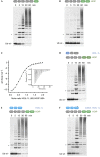LUBAC synthesizes linear ubiquitin chains via a thioester intermediate
- PMID: 22791023
- PMCID: PMC3432797
- DOI: 10.1038/embor.2012.105
LUBAC synthesizes linear ubiquitin chains via a thioester intermediate
Abstract
The linear ubiquitin chain assembly complex (LUBAC) is a RING E3 ligase that regulates immune and inflammatory signalling pathways. Unlike classical RING E3 ligases, LUBAC determines the type of ubiquitin chain being formed, an activity normally associated with the E2 enzyme. We show that the RING-in-between-RING (RBR)-containing region of HOIP--the catalytic subunit of LUBAC--is sufficient to generate linear ubiquitin chains. However, this activity is inhibited by the N-terminal portion of the molecule, an inhibition that is released upon complex formation with HOIL-1L or SHARPIN. Furthermore, we demonstrate that HOIP transfers ubiquitin to the substrate through a thioester intermediate formed by a conserved cysteine in the RING2 domain, supporting the notion that RBR ligases act as RING/HECT hybrids.
Conflict of interest statement
The authors declare that they have no conflict of interest.
Figures




Similar articles
-
The E3 ligase HOIP specifies linear ubiquitin chain assembly through its RING-IBR-RING domain and the unique LDD extension.EMBO J. 2012 Oct 3;31(19):3833-44. doi: 10.1038/emboj.2012.217. Epub 2012 Aug 3. EMBO J. 2012. PMID: 22863777 Free PMC article.
-
Structural basis for ligase-specific conjugation of linear ubiquitin chains by HOIP.Nature. 2013 Nov 21;503(7476):422-426. doi: 10.1038/nature12638. Epub 2013 Oct 20. Nature. 2013. PMID: 24141947 Free PMC article.
-
The HOIL-1L ligase modulates immune signalling and cell death via monoubiquitination of LUBAC.Nat Cell Biol. 2020 Jun;22(6):663-673. doi: 10.1038/s41556-020-0517-9. Epub 2020 May 11. Nat Cell Biol. 2020. PMID: 32393887
-
Linear ubiquitin chains: enzymes, mechanisms and biology.Open Biol. 2017 Apr;7(4):170026. doi: 10.1098/rsob.170026. Open Biol. 2017. PMID: 28446710 Free PMC article. Review.
-
RBR E3 ubiquitin ligases: new structures, new insights, new questions.Biochem J. 2014 Mar 15;458(3):421-37. doi: 10.1042/BJ20140006. Biochem J. 2014. PMID: 24576094 Free PMC article. Review.
Cited by
-
Hepatitis B Virus-Induced Parkin-Dependent Recruitment of Linear Ubiquitin Assembly Complex (LUBAC) to Mitochondria and Attenuation of Innate Immunity.PLoS Pathog. 2016 Jun 27;12(6):e1005693. doi: 10.1371/journal.ppat.1005693. eCollection 2016 Jun. PLoS Pathog. 2016. PMID: 27348524 Free PMC article.
-
How Is the Fidelity of Proteins Ensured in Terms of Both Quality and Quantity at the Endoplasmic Reticulum? Mechanistic Insights into E3 Ubiquitin Ligases.Int J Mol Sci. 2021 Feb 19;22(4):2078. doi: 10.3390/ijms22042078. Int J Mol Sci. 2021. PMID: 33669844 Free PMC article. Review.
-
Met1-linked ubiquitination in immune signalling.FEBS J. 2014 Oct;281(19):4337-50. doi: 10.1111/febs.12944. Epub 2014 Aug 12. FEBS J. 2014. PMID: 25060092 Free PMC article. Review.
-
HOIL1 mediates MDA5 activation through ubiquitination of LGP2.bioRxiv [Preprint]. 2024 Apr 3:2024.04.02.587772. doi: 10.1101/2024.04.02.587772. bioRxiv. 2024. PMID: 38617308 Free PMC article. Preprint.
-
Parkin structure and function.FEBS J. 2015 Jun;282(11):2076-88. doi: 10.1111/febs.13249. Epub 2015 Mar 16. FEBS J. 2015. PMID: 25712550 Free PMC article. Review.
References
-
- Pickart CM, Fushman D (2004) Polyubiquitin chains: polymeric protein signals. Curr Opin Chem Biol 8: 610–616 - PubMed
-
- Hershko A, Ciechanover A (1992) The ubiquitin system for protein degradation. Annu Rev Biochem 61: 761–807 - PubMed
-
- Huang TT, D’Andrea AD (2006) Regulation of DNA repair by ubiquitylation. Nat Rev Mol Cell Biol 7: 323–334 - PubMed
-
- Chen ZJ, Sun LJ (2009) Nonproteolytic functions of ubiquitin in cell signaling. Mol Cell 33: 275–286 - PubMed
Publication types
MeSH terms
Substances
Grants and funding
LinkOut - more resources
Full Text Sources
Other Literature Sources
Molecular Biology Databases

